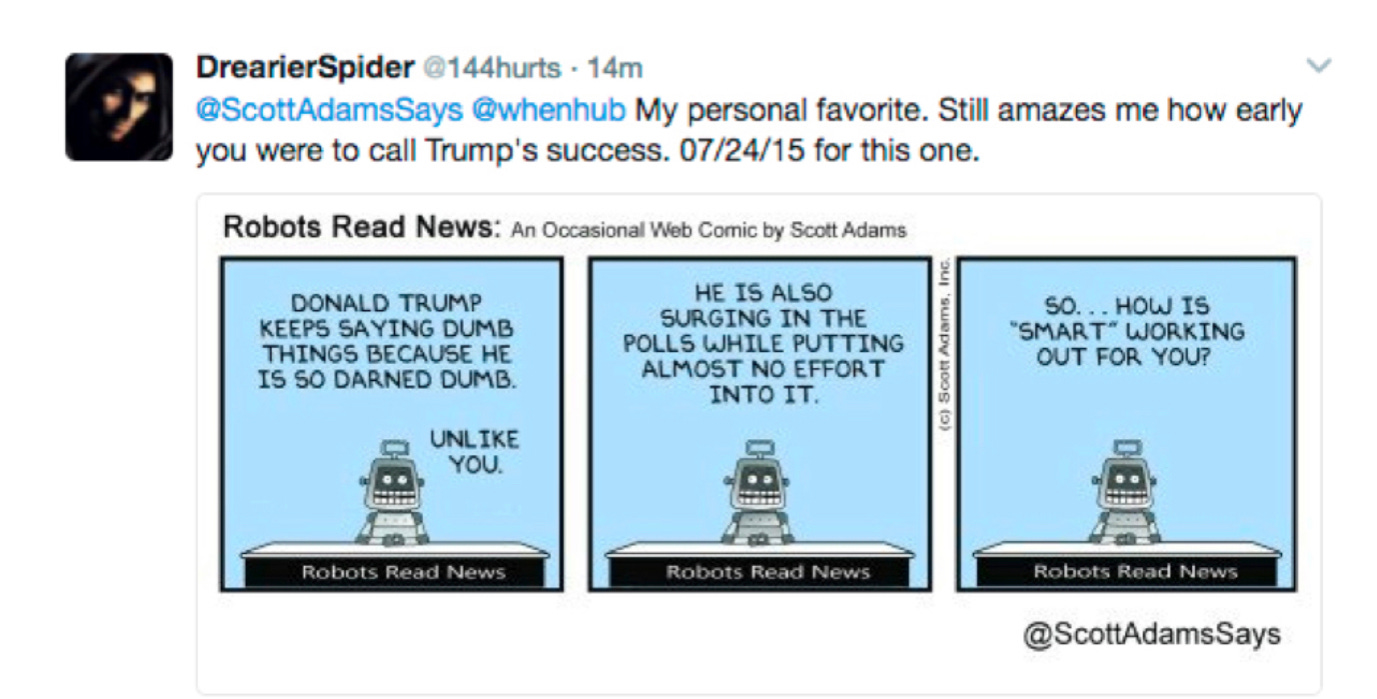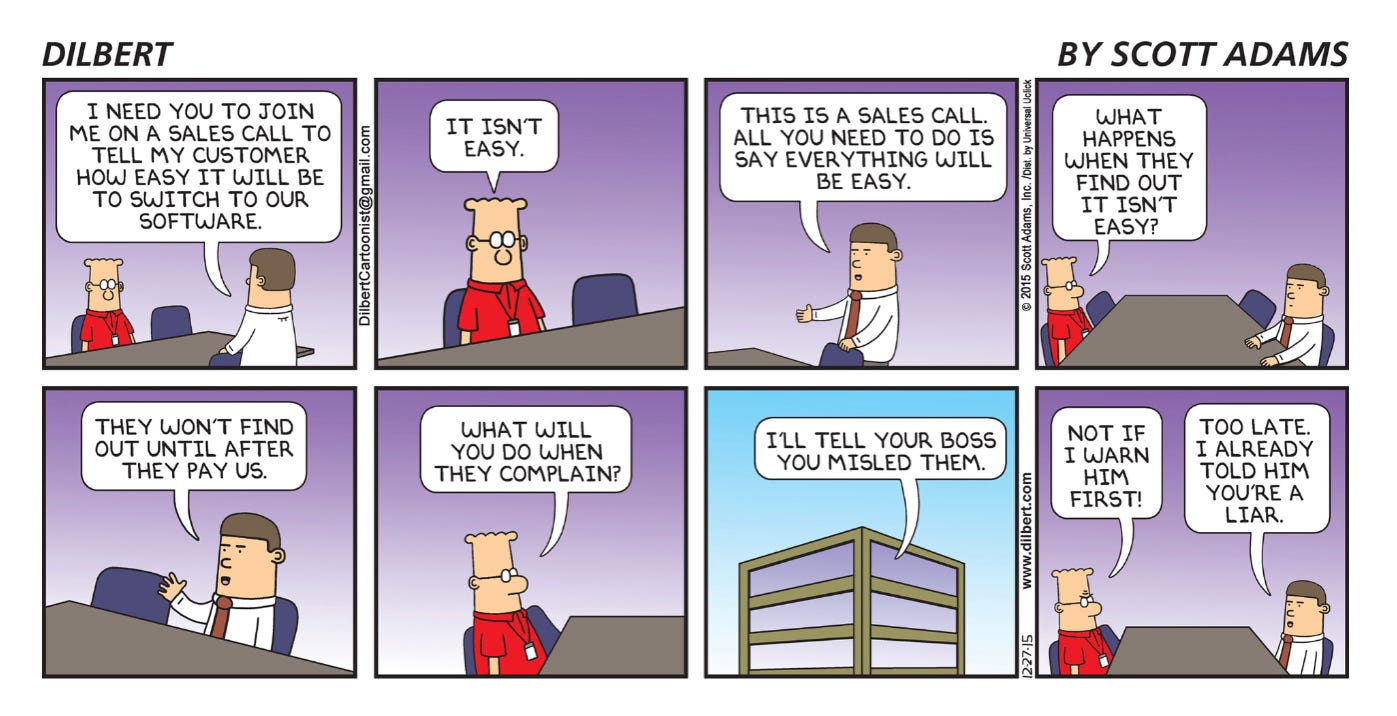This week we had a pretty short set of readings, as we covered Part 3 of Win Bigly: Persuasion in a World Where Facts Don’t Matter. It was only about 43 pages. So I hope you got it done!
By this time next week, you should read Part 4, which is a bit longer (about 75 pages). Have you found it easy reading? I find it’s not only smart, but entertaining. Speaking of which, let’s dive into the summary of Part 3, featuring the most entertaining President there ever was…
***
In Part 3, Scott Adams goes through his prime example of this book, Donald J. Trump. Remember, this is not a political book. Scott Adams professes to be an extreme liberal who does not like Trump’s political philosophy or policy positions. He’s in this game to help us understand Trump’s persuasion techniques. And for that, he uses Part 3 to remind us of the crazy 2016 election cycle.
“It all makes sense now,” I keep thinking as I read Scott Adams. However, we must remember that Scott Adams isn’t playing Monday morning quarterback. He is on the record with all of these points as far back as the early fall of 2015.
For starters, he gives us a sense of what a Talent Stack is: “a collection of skills that work well together and make the person with those skills unique and valuable.” He adds that “the power of the talent stack idea is that you can intelligently combine ordinary talents together to create extraordinary value. The key concept here is that the talents in the stack work well with one another.”
Adams tells us that a big reason for Trump’s persuasion effectiveness is because over his life he has accumulated a remarkable talent stack including the following:
Publicity: he understands its value and knows how to get it.
Reputation: most see him as a business person who get things done.
His branding can also be seeing everywhere, from golf courses to skyscrapers.
Strategy: He is good at making strategic decisions
Negotiating: He wrote the book!
Persuasion: The best persuader Adams has ever seen.
Public speaking: Entertaining and provocative.
Sense of humor: “He’s funny enough,” says the creator of Dilbert.
Quick on his feet: Has a natural talent for mental quickness.
Thick skinned: While some may think he’s “thin-skinned” because he attacks his critics, Adams says he’s actually super hardened against criticism because he has endured a lifetime of it.
High energy: Our brains interpret this as competence and leadership.
Size and appearance: Tall, distinctive look with stern face and unusual haircut.
Smart: Adams says he’s smarter than the average citizen and his deep experience across a number of fields makes his intelligence well rounded.
***
Adams doesn’t put a lot of stock in Trump’s public policies. In fact, he points out how Trump changed many of them while he was a candidate and later as President. “Trump is so persuasive that policies didn’t matter. People voted for him even as his policies were murky and changing.”
He also points to Trump’s “Rosie O’Donnell” moment in the Presidential primary debate of August 6, 2015 as one that convinced Adams that Trump would win the whole thing because the way he responded wasn’t normal and it sucked all the energy out of the room. He says it shows how “Trump used his weapons-grade persuasion and stacked together several techniques in a few sentences.” Let’s review those.
Trump created an emotion-triggering visual image (Rosie O’Donnell) that sucked all the attention from the question to the answer. He knew his Republican base would have a strong negative reaction to Rosie O’Donnell and so he bonded with them at that point. This is a the persuasion method known as pacing and leading. You match your audience’s emotional condition to gain trust, and later you are in a position to lead them. “Trump also used the High-Ground Maneuver by taking the question out of the weeds of what he said in the past and up to the concept of how much it hurts the world to be bound by such silly political corrections.”
In full, Adams says, “Trump’s response to [Megyn] Kelly was funny, strategic, smart, memorable, visually persuasive, thick skinned (he didn’t seem bothered), provocative, and perfectly on brand. He converted Kelly’s attack into pure energy and then moved that energy where it suited him best. Normal people can’t do that.”
***
In the next section of Part 3, Adams ranks the broad forms of persuasion by their relative power. Here they are ranked in order of their persuasiveness:
Big fear: More persuasive than a smaller one. A personal fear is more persuasive than a generic national problem.
Identity: Humans reflexively support their own tribe. No thinking is involved. Clinton appealed to genetic distinctions. Trump did a High-Ground Maneuver by speaking to the way we are socialized to feel patriotic. Adams says both strategies were very strong. He also suggests the next time someone is doing something you find objectionable, don’t attack that person’s actions. Instead, ask them if this is who the person wants to be.
Smaller fear: can be persuasive, but not all fear-related persuasion is equal.
Aspirations: These need to be relative to aspirations people have. Trump campaigned playing directly to voter aspirations. He told the unemployed and underemployed they would someday have good jobs. He’d make America safer, richer, and just plain greater, in a variety of ways.
Habit: If you want to influence someone to try a new product, it helps to associate it with some part of an existing habit. (Hello, James Clear!) However, this form of persuasion —grafting onto existing habits — usually isn’t helpful for politics because big national topics don’t fit into your daily habits.
Analogies: These fail in persuasion because they are not designed for that job. They are just a quick way to explain a new concept. And, they are imprecise by definition. That gives people on the other side of a debate ammunition.
Reason: Facts and policies and reason are almost useless in persuasion. The exception to this rule is when there is not emotional content to a decision and you have all the information you need.
Hypocrisy: “Your side did it too” is a weak response. The stronger avenue to take is the High-Ground Maneuver, which involves reframing it — being the adult in the room — to explain to children how things work. So whenever you see claims of hypocrisy, there is an opportunity for the High-Ground Maneuver.
Word-thinking: trying to win an argument by adjusting the definition of words.
***
Adams also explains the importance of mental anchors. By this, he means that the first thing you hear about a new topic automatically becomes an anchor in your mind that biases your future opinions. In the 3-D world of persuasion this makes a huge difference. If we accept the thing we hear first, it tends to harden into an irrational belief.
The Hitler analogy (against Trump) was effective, not because it was an analogy, but because any association of two things is persuasive. If you compare any two things long enough, their qualities start to merge in our irrational minds. This association worked on the kind of people who did not know who Trump was for most of his public life (particularly younger people and those who did not watch The Apprentice).
***
In the next section of Part 3, Adams explains to us how credibility is persuasive. He adds: “That’s why doctors and lawyers post their degrees on the wall where everyone can see them.” In addition, he says “it is easier to persuade people when they expect you to be persuasive.” By now, most people know Trump wrote a book (with a co-author, who actually wrote most of it) about how he is a great negotiator. Therefore most who go into a negotiation (or debate) with Trump expect to lose. They believe him to be a great persuader.
Adams says “pre-suading,” or setting the table, is about creating mental and emotional associations that carry over.” He tells us we can help “set the table” in some of these ways:
Dress the part
Improve your physical appearance (attractive people are more persuasive). You can do this by diet, exercise, hair care, good grooming, etc.
Broadcast your credentials in a way that appears natural and not braggy.
Brand yourself as a winner.
Meet in the most impressive space you can control.
Set expectations ahead of time.
Pre-suade with thoughts and images that will bias people towards a frame of mind that is compatible with your upcoming persuasion.
Bring high energy.
***
In the final section of Part 3, Adams asks the question of whether Trump is a “natural” persuader or if he learned it. He gives us his own analysis that he believes Trump learned most of the skills and techniques based on various experiences in his life, including attending the Marble Collegiate Church in New York City as a kid. Their famous pastor, Norman Vincent Peale, was the author of The Power of Positive Thinking and influenced millions. Trump had a front row seat and has talked about how Peale was a big influence on him. Adams calls this the “Peale” filter and argues that perhaps in some sense “Trump thought himself into the Presidency.”
Wow, does this remind you of some elements from the book, “The Intention Experiment,” which the Fearless Journeys book club read two months ago? It’s interesting how some of these books build on each other, isn’t it?
***
To conclude this summary, here is a list of some of the Persuasion Tips that Adams highlighted in Part 3. Don’t forget the first 12 Persuasion Tips were included in last week’s summary of Parts 1 and 2.
Persuasion Tip 13: Use the High-Ground Maneuver to frame yourself as the wise adult in the room. It forces others to join you or be framed as the small thinkers.
Persuasion Tip 14: When you attack a person’s belief, the person under attack is more likely to harden his belief than abandon it, even if your argument is airtight.
Persuasion Tip 15: Studies say humans more easily get addicted to unpredictable rewards than they do predictable rewards.
Persuasion Tip 16: It is easier to persuade a person who believes you are persuasive.
Persuasion Tip 17: People prefer certainty over uncertainty, even when the certainty is wrong.
***
It’s important as we read and digest this material, that we also spend some personal time to think and reflect about HOW we can APPLY these concepts to our own lives. How can you take what you learned here to your job? Your career? To advancing a sale? Selling a product? Selling yourself? Perhaps look at one concept in this chapter, or even just one persuasion tip, and think about how you can apply it right now. This week.
Think and reflect on that before you start reading this next week’s readings. However, don’t delay too long. We have 75 pages to read — all of Part 4 — which is focused on how to use persuasion in business and politics.





